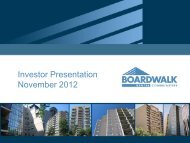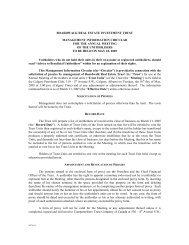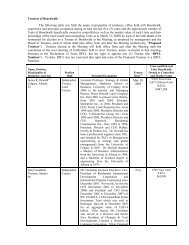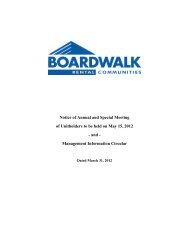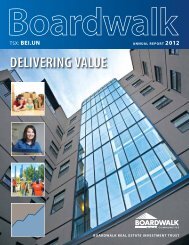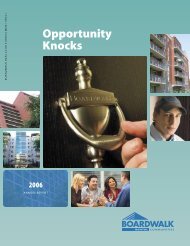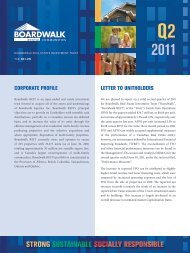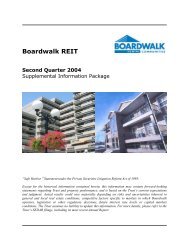BMO Financial Group - Outlook 2005(1.1Mb pdf File) - Boardwalk REIT
BMO Financial Group - Outlook 2005(1.1Mb pdf File) - Boardwalk REIT
BMO Financial Group - Outlook 2005(1.1Mb pdf File) - Boardwalk REIT
You also want an ePaper? Increase the reach of your titles
YUMPU automatically turns print PDFs into web optimized ePapers that Google loves.
5<br />
Rising interest rates...<br />
10-year Government Note Rate<br />
%<br />
6.0<br />
5.5<br />
5.0<br />
4.5<br />
4.0<br />
3.5<br />
3.0<br />
2002:Q1<br />
Q3<br />
2003:Q1<br />
Q3<br />
2004:Q1<br />
...will temper the pace of expansion in <strong>2005</strong>...<br />
Q3<br />
<strong>2005</strong>:Q1<br />
FORECAST<br />
Q3<br />
2006:Q1<br />
Q3<br />
global economy, suggests that the<br />
external sector will add to GDP growth in<br />
<strong>2005</strong> after subtracting from it in 2004.<br />
In addition, though household debt has<br />
risen to a record high relative to personal<br />
incomes, assets have climbed even<br />
faster largely as a result of rising home<br />
prices and recovering equity markets. In<br />
the second quarter of 2004, household<br />
net worth stood at a record high US$45.9<br />
trillion, up 11% from the year-earlier<br />
period and 19% from the recent trough in<br />
the third quarter of 2002. Therefore,<br />
barring a downturn in asset prices, the<br />
so-called “wealth effect” will continue to<br />
support household spending in <strong>2005</strong>.<br />
Gross Domestic Product<br />
Q/Q% Change, Annualized<br />
8.0<br />
7.0<br />
6.0<br />
5.0<br />
4.0<br />
3.0<br />
2.0<br />
1.0<br />
0.0<br />
2002:Q1<br />
Q3<br />
...though the jobless rate should decline further.<br />
Unemployment Rate<br />
%<br />
6.5<br />
6.0<br />
5.5<br />
5.0<br />
4.5<br />
2002:Q1<br />
Q3<br />
2003:Q1<br />
Q3<br />
Non-inflationary rate<br />
2003:Q1<br />
Q3<br />
2004:Q1<br />
2004:Q1<br />
Q3<br />
Q3<br />
<strong>2005</strong>:Q1<br />
<strong>2005</strong>:Q1<br />
FORECAST<br />
Q3<br />
2006:Q1<br />
FORECAST<br />
Q3<br />
2006:Q1<br />
Q3<br />
Q3<br />
…but joblessness should still fall…<br />
Continued above-potential growth should<br />
allow the unemployment rate to drift<br />
down from an expected 5.4% in the<br />
fourth quarter of 2004 to 5.1% by the end<br />
of <strong>2005</strong> and to 5.0% by late 2006. This<br />
means the economy will be operating at<br />
“full employment” – the jobless rate<br />
associated with stable inflation pressures<br />
in the long run – in about two years time.<br />
…assuming that productivity<br />
moderates<br />
Despite the rapid pace of output growth<br />
in recent years, job growth has been<br />
surprisingly weak. From 2001Q1 to<br />
2004Q2, real GDP expanded 9.1% but<br />
nonfarm payrolls shrank by one million<br />
workers. Firms managed to produce<br />
more output with fewer workers because<br />
of rising productivity. Output-per-hour<br />
worked rose a phenomenal 14.8% over<br />
this 3½-year span. If productivity had<br />
grown a couple of percentage points<br />
less, payrolls would have expanded by<br />
more than one million.<br />
If only because the recent pace is so far<br />
beyond the norm, productivity growth is





